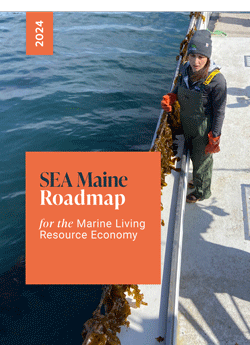The outlook for groundfish as a source of revenue for fishermen and protein for consumers has been gloomy at best. But according to a presentation at the Maine Fishermen’s Forum on March 1, there are untapped markets that may be cause for optimism.
Merritt Carey, who for four years has worked with SEA Maine—the Seafood Economic Accelerator for Maine, an industry-led initiative—highlighted the recent report the group published that provides a roadmap for growth for the sector.
Carey moderated a panel at which the report’s key points were explained. Under the heading “Seafood Markets and Marketing: What Are We Missing?” panelists used the report’s data to point to niches that are underserved.
Janine Cary of the Maine Center for Entrepreneurs said nationally, seafood sales over eight species were down 3.7% in 2023 over the previous year, though the data didn’t include the fourth quarter.
“People of color are eating far more seafood.”
The pandemic was a factor in some of the recent data, she and others said.
Bright spots included more frozen flounder selling in interior states, while South Atlantic and Mid-Atlantic states also were consuming more seafood.
“Those two markets are growing a lot,” Cary said. “They eat a lot of seafood.”
Seafood sold by a handful of large food service suppliers—selling to restaurants and institutions like hospitals and nursing homes—fell by 22.6% through July of last year, she said, some of which is attributed to inflation.
The 2023 overview, she said, was not good, with fresh seafood sales down by 16.8%, frozen seafood down 14.9%, and shelf stable seafood down 9.1%.

If there is a path toward boosting consumption consistently, Tae Chong, director of multicultural marketing and strategies for the Maine State Chamber of Commerce, provided it.
“The demographics are changing,” he said. “People of color are eating far more seafood. They also consume a diversity of seafood.”
U.S. residents on average consume 16 pounds of seafood annually, while Cambodians consume an average of 92 pounds annually. There are 35,000 people of Cambodian descent living in Lowell, Mass., Chong said, a community that was the subject of study.
Today, there are 22 million Americans whose families came from Southeast Asia, Chong said, and by 2060, Asian American immigrants will be the largest minority in the U.S., surpassing Hispanics. That population has quadrupled since 2000, he added.
Every large U.S. city now has a “minority majority” population, he added.
Data gathered in Portland shows the average monthly grocery bill at $1,211, with $68 devoted to seafood. The average household there ate seafood at home 2.8 times a month.
By comparison, the population surveyed in Lowell spent $932 a month on groceries, with seafood accounting for $171. Households ate seafood at home 12.8 times a month.
Ben Martens, director of Maine Coast Fishermen’s Association, highlighted flounder as “one of the success stories we’re seeing in our ocean.” Yet in December, some 30,000 pounds of the fish landed in Maine was sold for $1 per pound.
“We need to diversify,” he said, so fishermen can find new species to catch, matched to new markets.
“We have fish in the ocean,” he said, with marine scientists saying that 30 million pounds of fish in the Gulf of Maine could be landed that are not being caught.
Seaweeds also hold potential for growth, said panelist Liz MacDonald of Atlantic Sea Farms. With a $17.8 billion global market in 2022, Maine growers have opportunity, she said. Seaweed snacks are being embraced by millennials, she said, and campus food services, along with hospitals and nursing homes, are including seaweed “for a healthier option.”
To read the full SEA Maine report, visit: seamaine.org/reports-presentations.





